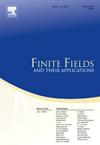Computing the minimum distance of the C(O3,6) polar orthogonal Grassmann code with elementary methods
IF 1.2
3区 数学
Q1 MATHEMATICS
引用次数: 0
Abstract
The polar orthogonal Grassmann code is the linear code associated to the polar orthogonal Grassmannian subvariety of the Grassmannian. The variety is the Grassmannian of 3-spaces contained in a hyperbolic quadric in . In this manuscript we prove that the minimum distance of the polar orthogonal Grassmann code is for q odd and for q even. We also prove that the minimum distance of is when q is even. Our technique is based on partitioning into different sets such that on each partition the code is identified with evaluations of determinants of skew–symmetric matrices. Our bounds come from elementary algebraic methods counting the zeroes of particular classes of polynomials. The techniques presented in this paper may be adapted for other polar Grassmannians.
用初等方法计算C(o3,6)极正交格拉斯曼码的最小距离
极正交格拉斯曼码C(o3,6)是与格拉斯曼子的极正交格拉斯曼子相关的线性码。变量o3,6是PG(6,q)中的双曲二次曲面所包含的3-空间的格拉斯曼年。本文证明了极坐标正交格拉斯曼码C(o3,6)的最小距离为q3−q2 (q为奇数)和q3 (q为偶数)。我们还证明了当q为偶数时,C(o4,8)的最小距离为q6。我们的技术基于将o3,6划分为不同的集合,这样在每个划分上,代码C(o3,6)被识别为斜对称矩阵的行列式的评估。我们的界限来自初等代数方法,计算特定多项式类的零。本文提出的技术可能适用于其他极地格拉斯曼人。
本文章由计算机程序翻译,如有差异,请以英文原文为准。
求助全文
约1分钟内获得全文
求助全文
来源期刊
CiteScore
2.00
自引率
20.00%
发文量
133
审稿时长
6-12 weeks
期刊介绍:
Finite Fields and Their Applications is a peer-reviewed technical journal publishing papers in finite field theory as well as in applications of finite fields. As a result of applications in a wide variety of areas, finite fields are increasingly important in several areas of mathematics, including linear and abstract algebra, number theory and algebraic geometry, as well as in computer science, statistics, information theory, and engineering.
For cohesion, and because so many applications rely on various theoretical properties of finite fields, it is essential that there be a core of high-quality papers on theoretical aspects. In addition, since much of the vitality of the area comes from computational problems, the journal publishes papers on computational aspects of finite fields as well as on algorithms and complexity of finite field-related methods.
The journal also publishes papers in various applications including, but not limited to, algebraic coding theory, cryptology, combinatorial design theory, pseudorandom number generation, and linear recurring sequences. There are other areas of application to be included, but the important point is that finite fields play a nontrivial role in the theory, application, or algorithm.

 求助内容:
求助内容: 应助结果提醒方式:
应助结果提醒方式:


